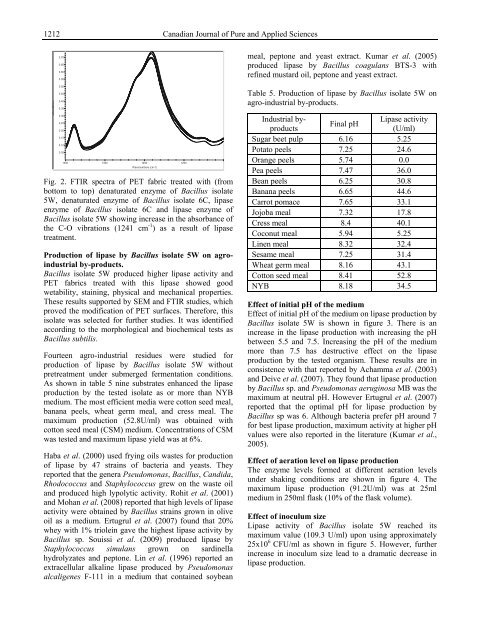Download (5Mb) - Covenant University Repository
Download (5Mb) - Covenant University Repository
Download (5Mb) - Covenant University Repository
You also want an ePaper? Increase the reach of your titles
YUMPU automatically turns print PDFs into web optimized ePapers that Google loves.
1212<br />
A bsorbance<br />
0.70<br />
0.65<br />
0.60<br />
0.55<br />
0.50<br />
0.45<br />
0.40<br />
0.35<br />
0.30<br />
0.25<br />
0.20<br />
0.15<br />
0.10<br />
0.05<br />
1350<br />
1300<br />
1250<br />
Wavenumbers (cm-1)<br />
Fig. 2. FTIR spectra of PET fabric treated with (from<br />
bottom to top) denaturated enzyme of Bacillus isolate<br />
5W, denaturated enzyme of Bacillus isolate 6C, lipase<br />
enzyme of Bacillus isolate 6C and lipase enzyme of<br />
Bacillus isolate 5W showing increase in the absorbance of<br />
the C-O vibrations (1241 cm -1 ) as a result of lipase<br />
treatment.<br />
Production of lipase by Bacillus isolate 5W on agroindustrial<br />
by-products.<br />
Bacillus isolate 5W produced higher lipase activity and<br />
PET fabrics treated with this lipase showed good<br />
wetability, staining, physical and mechanical properties.<br />
These results supported by SEM and FTIR studies, which<br />
proved the modification of PET surfaces. Therefore, this<br />
isolate was selected for further studies. It was identified<br />
according to the morphological and biochemical tests as<br />
Bacillus subtilis.<br />
Fourteen agro-industrial residues were studied for<br />
production of lipase by Bacillus isolate 5W without<br />
pretreatment under submerged fermentation conditions.<br />
As shown in table 5 nine substrates enhanced the lipase<br />
production by the tested isolate as or more than NYB<br />
medium. The most efficient media were cotton seed meal,<br />
banana peels, wheat germ meal, and cress meal. The<br />
maximum production (52.8U/ml) was obtained with<br />
cotton seed meal (CSM) medium. Concentrations of CSM<br />
was tested and maximum lipase yield was at 6%.<br />
Haba et al. (2000) used frying oils wastes for production<br />
of lipase by 47 strains of bacteria and yeasts. They<br />
reported that the genera Pseudomonas, Bacillus, Candida,<br />
Rhodococcus and Staphylococcus grew on the waste oil<br />
and produced high lypolytic activity. Rohit et al. (2001)<br />
and Mohan et al. (2008) reported that high levels of lipase<br />
activity were obtained by Bacillus strains grown in olive<br />
oil as a medium. Ertugrul et al. (2007) found that 20%<br />
whey with 1% triolein gave the highest lipase activity by<br />
Bacillus sp. Souissi et al. (2009) produced lipase by<br />
Staphylococcus simulans grown on sardinella<br />
hydrolyzates and peptone. Lin et al. (1996) reported an<br />
extracellular alkaline lipase produced by Pseudomonas<br />
alcaligenes F-111 in a medium that contained soybean<br />
Canadian Journal of Pure and Applied Sciences<br />
1200<br />
meal, peptone and yeast extract. Kumar et al. (2005)<br />
produced lipase by Bacillus coagulans BTS-3 with<br />
refined mustard oil, peptone and yeast extract.<br />
Table 5. Production of lipase by Bacillus isolate 5W on<br />
agro-industrial by-products.<br />
Industrial byproducts<br />
Final pH<br />
Lipase activity<br />
(U/ml)<br />
Sugar beet pulp 6.16 5.25<br />
Potato peels 7.25 24.6<br />
Orange peels 5.74 0.0<br />
Pea peels 7.47 36.0<br />
Bean peels 6.25 30.8<br />
Banana peels 6.65 44.6<br />
Carrot pomace 7.65 33.1<br />
Jojoba meal 7.32 17.8<br />
Cress meal 8.4 40.1<br />
Coconut meal 5.94 5.25<br />
Linen meal 8.32 32.4<br />
Sesame meal 7.25 31.4<br />
Wheat germ meal 8.16 43.1<br />
Cotton seed meal 8.41 52.8<br />
NYB 8.18 34.5<br />
Effect of initial pH of the medium<br />
Effect of initial pH of the medium on lipase production by<br />
Bacillus isolate 5W is shown in figure 3. There is an<br />
increase in the lipase production with increasing the pH<br />
between 5.5 and 7.5. Increasing the pH of the medium<br />
more than 7.5 has destructive effect on the lipase<br />
production by the tested organism. These results are in<br />
consistence with that reported by Achamma et al. (2003)<br />
and Deive et al. (2007). They found that lipase production<br />
by Bacillus sp. and Pseudomonas aeruginosa MB was the<br />
maximum at neutral pH. However Ertugrul et al. (2007)<br />
reported that the optimal pH for lipase production by<br />
Bacillus sp was 6. Although bacteria prefer pH around 7<br />
for best lipase production, maximum activity at higher pH<br />
values were also reported in the literature (Kumar et al.,<br />
2005).<br />
Effect of aeration level on lipase production<br />
The enzyme levels formed at different aeration levels<br />
under shaking conditions are shown in figure 4. The<br />
maximum lipase production (91.2U/ml) was at 25ml<br />
medium in 250ml flask (10% of the flask volume).<br />
Effect of inoculum size<br />
Lipase activity of Bacillus isolate 5W reached its<br />
maximum value (109.3 U/ml) upon using approximately<br />
25x10 6 CFU/ml as shown in figure 5. However, further<br />
increase in inoculum size lead to a dramatic decrease in<br />
lipase production.

















